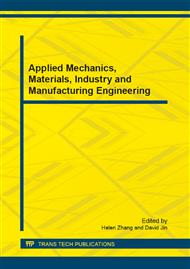p.132
p.137
p.142
p.146
p.150
p.154
p.158
p.162
p.166
Synthesis and Properties of a Novel Material Chemistry Unsymmetrical Material, Diarylethene with Cyano
Abstract:
A unsymmetrical photochromic diarylethene, 1-{[2-methyl-5-(1,3-dioxolane)-3-thienyl]} -2-[2-methyl-5-(4-cyanophenyl)-3-thienyl]perfluorocyclopentene(1a),was synthesized, and its optoelectronic properties were also investigated in detail. The results showed that this compound exhibited reversible photochromism, changing from colorless to blue violet after irradiation with UV light both in solution and in PMMA amorphous film.The diarylethene exhibited a fluorescence switches along with the photochromism from open-ring isomers to closed-ring isomers. When irradiated by UV light, the photocyclization reaction was occurred and the emission intensity of the diarylethene decreased significantly, due to producing the non-fluorescence closed-ring isomers. The back irradiation by appropriate wavelength visible light regenerated its open-ring isomers and recovered the original emission intensity
Info:
Periodical:
Pages:
150-153
Citation:
Online since:
April 2012
Authors:
Price:
Сopyright:
© 2012 Trans Tech Publications Ltd. All Rights Reserved
Share:
Citation:


